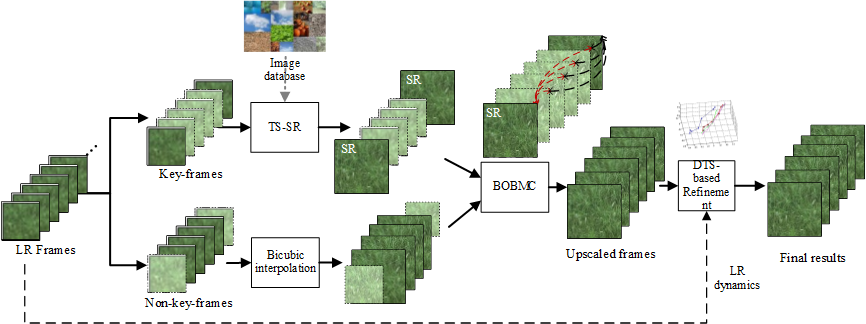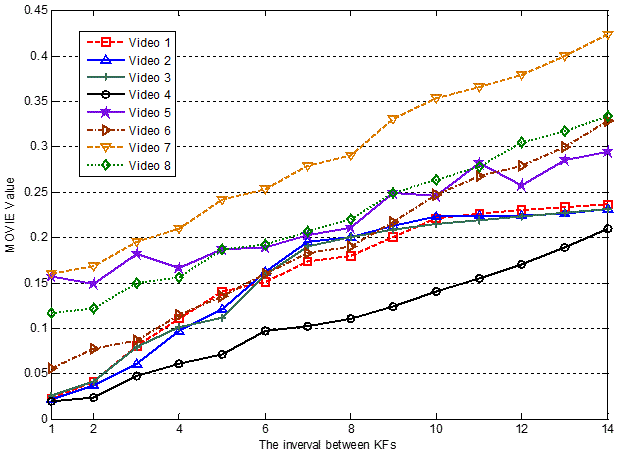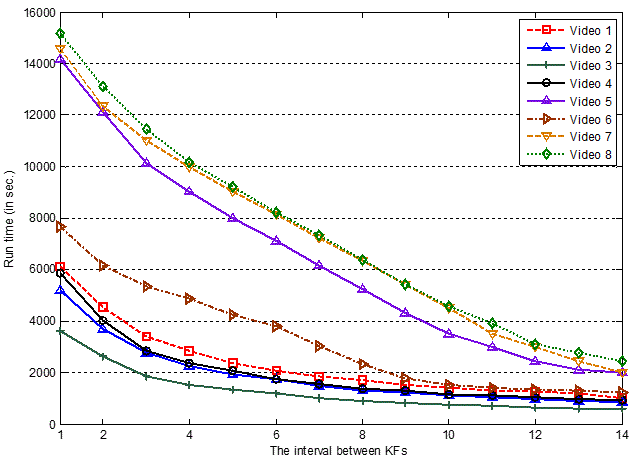
Video Super-Resolution Project |
1Chih-Chun Hsu, 1Chia-Wen Lin, and 2Li-Wei Kang |
1Department of Electrical Engineering National Tsing Hua University Hsinchu 30013, Taiwan 2Department of Computer Science and Information Engineering National Yunlin University of Science and Technology Yunlin 640 , Taiwan |

Fig. 1. Block diagram of the proposed
DTS-SR framework.
The key-frames are first uniformly sampled from the LR input video with an
interval of
|
This paper addresses the problem of hallucinating the missing
high-resolution (HR) details of a low-resolution (LR) video while
maintaining the temporal coherence of the reconstructed HR details by
using dynamic texture synthesis (DTS). Most existing multi-frame-based
video super-resolution (SR) methods suffer from the problem of limited
reconstructed visual quality due to inaccurate sub-pixel motion
estimation between frames in a LR video. To achieve high-quality
reconstruction of HR details for a LR video, we propose a
texture-synthesis-based video SR method,
as shown in Fig. 1,
in which a novel DTS scheme is proposed to render the reconstructed HR
details in a temporally coherent way, which effectively addresses the
temporal incoherence problem caused by traditional texture synthesis
based image SR methods. To further reduce the complexity of the proposed
method, our method only performs the texture synthesis-based SR (TS-SR)
on a set of key-frames, while the HR details of the remaining
non-key-frames are simply predicted using the bi-directional overlapped
block motion compensation. After all frames are upscaled, the proposed
DTS-SR is applied to maintain the temporal coherence in the HR video.
Experimental results demonstrate that the proposed method achieves
significant subjective and objective visual quality improvement over
state-of-the-art video SR methods. |
Main menu
Data
Experimental Result

Fig. 2.
Block diagram of proposed DTS-based refinement.

Fig. 3. Examples of low-dimensional trajectories projected from the ground-truth HR textural patches (red), its downscaled LR patches (pink), the HR patches upscaled from the LR patches via TS-SR+BOBMC (blue), and the SR patches via the proposed DTS-SR method (green), respectively. The three axes, PC-I, PC-II, and PC-III indicate the first, second, and third principal components of a video patch projected using PCA.
Fig.
2
depicts the proposed
DTS-based refinement scheme, in which both the input LR frames and the
reconstructed HR frames obtained via hybrid TS-SR/BOBMC are used to derive
temporally coherent HR video frames. Our
method is based on the assumption that
the content of a textural patch varies along time and the transition between the
textures can be modeled as a linear or nonlinear system [21]-[23],
[34].
Fig.
3 shows the four projected
trajectories of the ground-truth HR patches, the downscaled LR patches, the SR
patches via hybrid TS-SR/BOBMC, and the SR patches via the proposed DTS-SR method (i.e., hybrid
TS-SR/BOBMC followed by DTS-based refinement), respectively. We can observe from
Fig. 5 that the trajectory of the SR patches obtained via DST-SR is much
closer to the ground-truth trajectory compared to that of the SR patches
obtained via hybrid TS-SR/BOBMC. As a
result, the proposed DTS-SR method can well address the temporal incoherence
problem in video SR which can also be observed from the
SR videos.
See video demo pages to get
more information.

Fig. 4. Objective visual qualities evaluated by MOVIE for the eight reconstructed SR Videos with different interval lengths between two successive key-frames (KFs).

Fig. 5. Run-time complexity (in seconds) comparison of the proposed SR method for the eight test videos with different interval lengths between two successive key-frames (KFs).
Note, the selection of the
number of non-key-frames between two successive key-frames will influence both
the visual quality and computational complexity. Fig.
4 compares the visual
qualities of reconstructed HR videos using our method with different values of
Table 1: Rum-Time (in Seconds) Comparisons among the Evaluated Methods Used for Comparisons and the Proposed Method.

The proposed method was implemented in MATLAB 64-bit version with Windows 8.1 operation system on a personal computer equipped with Intel i7 processor and 32 GB memory. To evaluate the computational complexity of the proposed algorithm, the run-time of each compared method is listed in Table 1, which shows that the proposed method is significantly faster than ASDS-SR and TS-SR.
[19]
E. M. Hung, R. L. de Queiroz, F. Brandi, K. F. de Oliveira, and D. Mukherjee,
“Video super-resolution using codebooks derived from key-frames,”
IEEE Trans. Circuits Syst. Video
Technol.
vol. 22, no. 9, pp. 1321–1331, Sept. 2012.
[21]
A.
Schödl, R.
Szeliski, D.
Salesin,
and I.
A. Essa,
“Video
textures,”
in Proc.
ACM SIGGRAPH,
New Orleans, LA, USA, July 2000,
pp.
489−498.
[22]
G.
Doretto, A.
Chiuso, Y.
N.
Wu,
and S.
Soatto,
“Dynamic
textures,”
Int.
J.
Comput. Vis.,
vol. 51,
no. 2,
pp. 91−109,
2003.
[26]
Y. HaCohen, R. Fattal, and D. Lischinski, “Image upsampling via texture
hallucination,” in Proc.
IEEE Int.
Conf.
Comput. Photography,
Cambridge,
MA,
USA, pp. 20−30,
Mar.
2010.
[34]
R. Costantini, L. Sbaiz, and S. Süsstrunk, ”Higher order SVD analysis for
dynamic texture synthesis, IEEE Trans. Image Process., vol. 17, no. 1, pp. 42–52, Jan. 2008.
| See Also: |